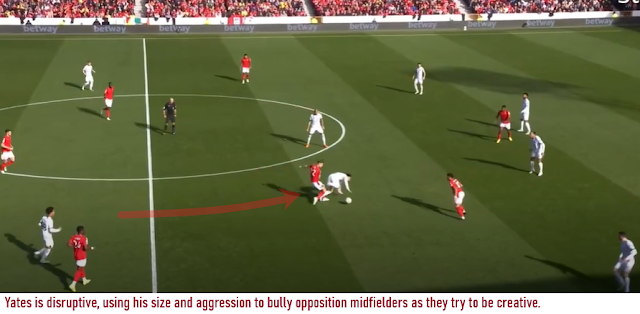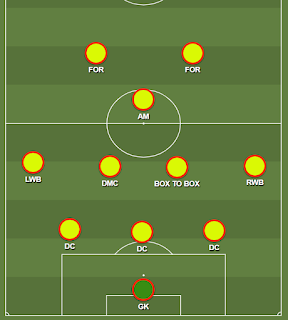Forest's defensive improvement
"I'm not sure where I should put praise on. They're a great team, Steve [Cooper]'s a fantastic manager, for us, we have to win here - done - but we didn't. Credit to Nottingham, it was us against the goalkeeper, us against ourselves and not us against Nottingham Forest." - Jurgen Klopp
Jurgen Klopp's post-game comments last week failed to give much credit to Forest, despite the result being at least in part due to huge improvements in their defensive game.
Steve Cooper has changed Forest’s way of playing in an effort to tighten defensively. Moving to four at the back, he is using a 4-3-3 formation in an effort to get back to basics, concentrating on defending key areas during the difficult transition to elite football. This game saw him make a couple of changes, however we are beginning to see more of a settled side as he tries to build an understanding on the pitch.
The Reds were certainly fortunate that, as well as missing players, Liverpool appear unsettled tactically. Rather than the familiar 4-3-3, using which Jurgen Klopp’s side have pressed and progressed the ball with so much fluidity, they have been experimenting with 4-2-3-1 and 4-4-2 systems, the latter of which lined up at The City Ground.The unfamiliarity of this Liverpool side probably impacted on their ability in a similar way to how Forest have been struggling, but they still dominated the ball and territorially, enjoying a stifling 75.2% of possession as the game settled into long periods of intense pressure punctuated by regular, but often rushed, efforts to break away on the counter attack by Forest.
Withstanding this pressure from a top class team is an achievement. There had already been a gradual upturn – concentrating on defending deep and narrow in Cooper’s 4-3-3 has seen Forest’s goals conceded drop to 0.5 goals per game compared to 2.6 with the three man defence.
They have surrendered territory, and been relatively unambitious to achieve this – going back to basics – but during this game there were signs of Forest expanding on the areas they are willing to defend.
Klopp had a clear plan of slipping down the flanks to exploit Forest’s recent acquiescence in this part of the pitch, however Forest were more flexible in this game, able to fluidly switch into a 4-5-1 shape.
Jesse Lingard and Morgan Gibbs-White were key in this strategy; they worked tirelessly but more importantly knew when to revert to the wider shape. This ability to both clog up the middle of the pitch in a block of six, in front of the defence, while simultaneously blanketing the width with a line of five, made it difficult for Liverpool to break lines.
The versatility of the Forest defensive shape was further evidenced by the conditional press they employed.
We have seen Forest allow recent opponents to have the ball in their own half, and often in much deeper areas out wide, but The Reds pressed regularly and slightly higher in this game, despite the higher class of opponent.
We also saw a specific press triggered from central midfield. Klopp used Curtis Jones here; it was clear his role would be to play the ball forward, however Cooper gave him special treatment, unleashing Ryan Yates on Jones when he showed for possession in certain areas of the pitch.
Yates carried out this role unerringly well, picking good times to bully the smaller man, but perhaps it was what happened behind Yates that was the most interesting - Liverpool recognised and sought out the gap Yates left, however the other Forest players reacted to the press and were already pushed up to fill this space.
Where earlier in the season, the unfamiliar Forest players were not on the same wavelength, now they were working much more as a team. The Reds were still pressing relatively unambitiously, limiting the situations in which they could be caught out, however they certainly expanded in this regard. It was a big improvement.
The midfield trio of Yates, Remo Freuler and Cheikhou Kouyate were particularly impressive, preventing Liverpool from playing through this area of the pitch and starting off counter-attacks on the turnover.
The defenders were also key, stepping forward well. Roberto Firmino and Mo Salah were attempting to drop off into any space that appeared but were neutralised as Forest worked as a team.
Faced with a solid wall of garibaldi shirts, Liverpool struggled to create chances from open play. Forest soaked up the possession, attempting to counter-attack.
This defensive solidity contributed to the Forest goal; Joe Gomez, denied an outlet with The Reds sitting deep, dwelt on the ball and had to foul Taiwo Awoniyi – the set play leading to the goal.
Liverpool cranked up the pressure throughout – it was interesting to see how a class side went about picking apart an entrenched defence.
The middle of the pitch was defended too aggressively, so Liverpool continued to work the flanks.
Their runners tried to create space here – Firmino and Salah were the main culprits, dropping in and around the midfielders, trying to drag them away just before the real attack was launched. Kouyate in particular has been a victim of this previously, however it appears he has learned to trust his teammates, playing a much more disciplined game.
When Liverpool created overloads, the midfielders made good choices and worked hard to ensure the full-backs were not isolated, and any space in behind them was at least contested.
They attacked the gap between Forest’s full-backs and their nearest central defender again and again. In Cooper’s conservative 4-3-3 system, the center-back’s role is to stay narrow, potentially leaving this area vulnerable. The midfielders were responsible for plugging this space, which they did diligently.
Liverpool persevered. As the pressure increased Cooper reinforced this part of the pitch, switching to a back three. The three central defenders could now cover a wider area of the pitch, reducing the space appearing here.
This tactical switch in turn freed up the midfielders to spend more time defending the edge of the box and helping the full-backs.
It was still a scrambled, desperate affair, but Forest defended fantastically during open play. Liverpool’s main threat came from set-pieces, from which they fashioned several good chances.
When we think of The Premier League we imagine silky football, passing teams rampaging forward; it is worth recognising how dangerous elite teams are at attacking set-plays. Liverpool are a good example - they could have scored a couple of goals were it not for some brilliant saves by Dean Henderson, and poor, (albeit pressured) finishing.
Klopp was keen to highlight these misses but Forest could have scored more goals themselves – The Reds defended very well, broke, and forced Liverpool into several stunning pieces of last-gasp defending.
Liverpool had issues going into this match, so we should not get too carried away. But Forest were much improved defensively, playing more as a team then we have seen previously - this victory was about far more than Klopp's team missing chances. It was about grit, effort, organisation and trust.
The question is, can Steve Cooper replicate this consistently, and against teams with less problems, in the coming weeks?













Excellent analysis
ReplyDeleteBrilliant read as always.
ReplyDeleteYour twitter has been hacked
ReplyDelete